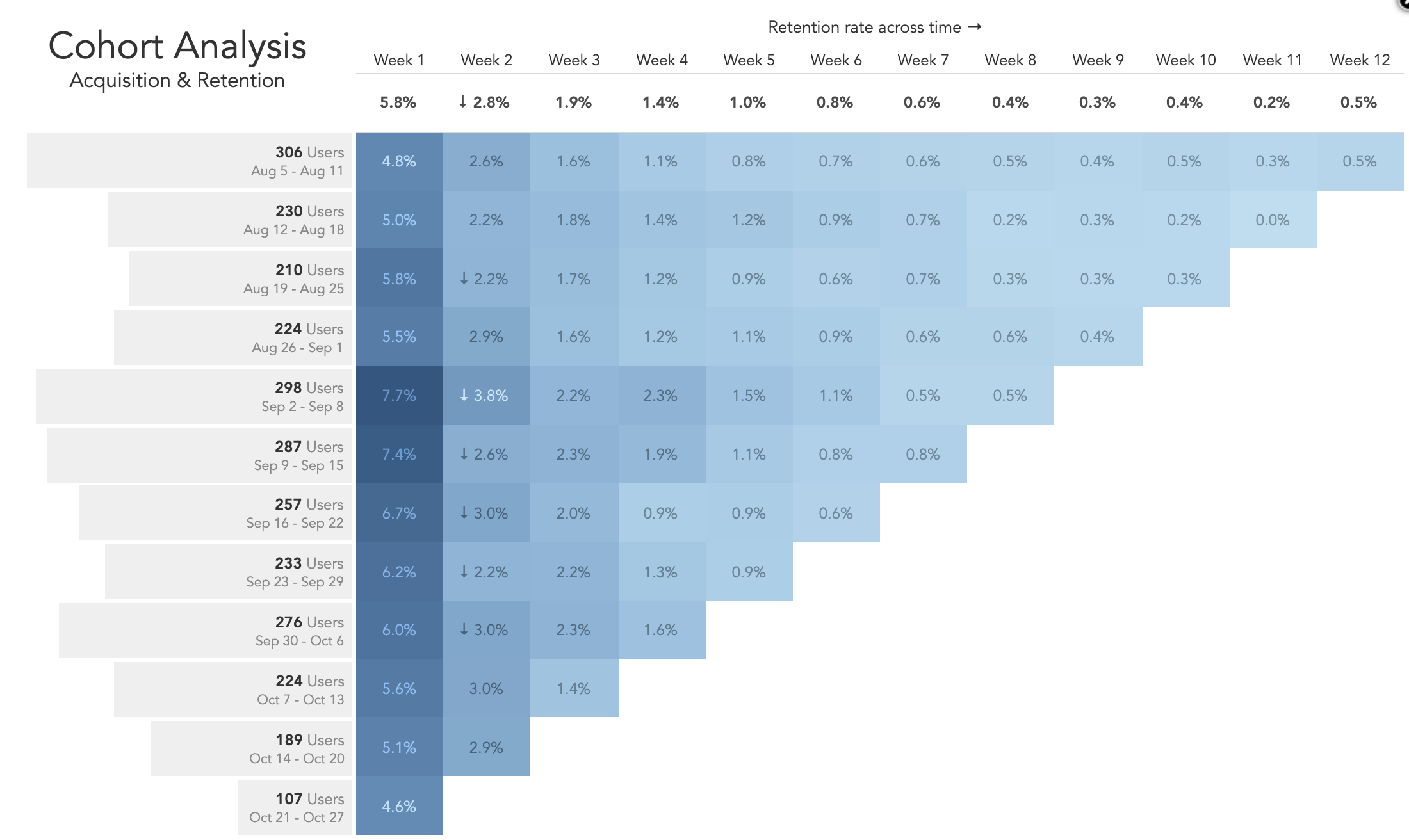Mastering Retention - The Key to Product Success

As a product person, one of our key goals is to build products that provide value and delight to the users. However, acquiring new users is only half the battle. Retaining those users over time is equally crucial for the long-term success of the product. Retention is a measure of how well the product can keep the users engaged and coming back, and it's a crucial metric that every product person should prioritize.
Why Retention Matters
Revenue and Growth: For products with a subscription or recurring revenue model, retaining existing users is often more cost-effective than acquiring new ones. Losing users means losing revenue, and acquiring new users can be expensive due to marketing and acquisition costs.
User Feedback and Improvement: Retaining users over time means you have a stable base of engaged users who can provide valuable feedback and insights. This feedback can help you understand pain points, identify areas for improvement, and prioritize feature development.
Network Effects: Many products benefit from network effects, where the product's value increases as more users join. High retention rates help build and maintain a vibrant user community, which can attract new users and create a virtuous growth cycle.
How do I measure Retention?

Here are some common methods to measure retention in product management:
Retention Rate: This is the percentage of users who continue using the product after a specific time period (e.g., week, month, quarter). It's calculated by taking the number of users remaining at the end of the period divided by the number of users at the start.
Retention Rate = (Users Remaining at End of Period) / (Users at Start of Period)
Churn Rate: The opposite of retention rate, the churn rate measures the percentage of users who stop using the product during a given period. It's calculated by taking the number of users who churned (stopped using) divided by the total number of users at the start.
Churn Rate = (Users Who Churned) / (Total Users at Start)
Cohort Analysis: This method tracks user retention by grouping users into cohorts based on when they signed up or performed a specific action. We can then analyze how each cohort's retention evolves over time intervals (day 1, day 7, day 30, etc.)
Daily/Weekly/Monthly Active Users (DAU/WAU/MAU): These metrics measure the number of unique users who actively engaged with the product within a specific time window (day, week, month). Tracking these over time can reveal retention trends.
Session Length/Frequency: Average session length and frequency of sessions per user can indicate engagement and usage habits tied to retention.
Feature Adoption: Measuring adoption rates of key features reveals which aspects of the product drive retention most effectively.
Surveys and Qualitative Feedback: Direct user feedback through surveys, interviews, or other qualitative methods can uncover reasons for churning or disengagement, providing insights to improve retention.
The right retention metrics depend on the product, business model, and goals. It's better to combine multiple approaches to gain a comprehensive picture of user retention and identify areas for optimization. Tools like cohort analysis, event tracking, and robust analytics solutions can greatly assist in accurate retention measurement.
How do I improve Retention?
Here are some effective strategies to improve user retention for your product
Onboarding Optimization: A well-designed onboarding experience can significantly boost retention by helping users quickly understand your product's value and how to use it effectively. Iteratively improve your onboarding flow based on data and user testing to reduce friction and accelerate time-to-value.
In-App Guidance and Education: Even after onboarding, continue to provide contextual guidance, tips, tutorials, and documentation within your product. Make it easy for users to discover advanced features and use cases as their needs evolve.
Email Nurturing Campaigns: Set up automated email campaigns to re-engage inactive users, share new feature updates, offer tips and use cases, and provide any other timely and relevant content. Well-timed emails can pull users back into the product experience.
Incentives and Gamification: Incorporate incentives like rewards, badges, levels, or other gamification elements to motivate continued usage. You can also offer time-limited promotions or loyalty programs to encourage engagement.
Gather Feedback and Act On It: Continuously gather user feedback through surveys, support interactions, social monitoring, and other channels. Quickly address any pain points or requested improvements that arise to increase satisfaction and reduce churn.
Cultivate a Community: Foster a vibrant user community by enabling user-to-user interactions, offering community forums/channels, hosting events/meetups, and facilitating networking. Building an active community of users helps keep them hooked to the product for longer.
Personalized Experiences: Leverage user data and machine learning to personalize recommendations, content, messaging, and overall user experiences based on preferences and behaviors. Personalized relevance drives greater value perception.
Scalable Engagement Notifications: Implement intelligent notification systems (in-app, email, mobile push) to nudge users towards their "aha!" moments and drive key value-driving actions. Be mindful not to over-notify.
Well-timed Feature Releases: Time major new feature/product releases strategically to help reactive churned/inactive users and give loyal users fresh reasons to re-engage.
Analytics and Measurement: Rigorously measure retention rates across different user segments/cohorts and A/B test changes to iteratively optimize for maximum user stickiness.
The key is adopting a holistic, data-driven approach that touches all stages of the user lifecycle - always making the product valuable and more indispensable over time.
Pitfalls to avoid while working on Retention
When working on improving user retention, it's important to be mindful of some potential pitfalls that can undermine our efforts. Here are some common pitfalls to avoid
Prioritizing Acquisition Over Retention: It's tempting to focus more resources on acquiring new users rather than retaining existing ones. However, neglecting retention can lead to a "leaky bucket" scenario where you're constantly churning users. Strike a balance between acquisition and retention strategies.
Lack of Data and Measurement: Failing to properly instrument the product and measure retention metrics can leave us flying blind. Ensure you have robust analytics and cohort analysis capabilities to identify retention issues and measure the impact of your efforts.
One-Size-Fits-All Approach: Different user segments may have varying needs, behaviors, and motivations. A blanket retention strategy is unlikely to be effective. Tailor your approaches based on user personas, lifecycle stages, and other relevant factors.
Overemphasis on Surface Metrics: Solely focusing on metrics like DAU/MAU or session length may provide an incomplete picture. Look deeper into engagement quality, key activations, and drivers of perceived value.
Ignoring User Feedback: Failing to actively solicit and act on user feedback can cause you to miss crucial insights into what's causing churn or disengagement. Invest in gathering qualitative feedback through surveys, interviews, and support interactions.
Lack of Cross-Functional Alignment: User retention requires coordination across various teams like product, engineering, marketing, support, and more. Siloed efforts can lead to disjointed and ineffective retention programs.
Overwhelming or Intrusive Tactics: While nudges and notifications can be effective, being too aggressive or intrusive can backfire and annoy users. Find the right balance and respect user preferences.
Neglecting the Entire User Journey: Retention efforts often focus too narrowly on certain stages like onboarding or reactivation. However, a seamless and delightful experience is required across the entire user journey.
Chasing Vanity Metrics: Be wary of chasing shallow engagement metrics that don't translate to real value or revenue. Align your retention goals with your business model and what truly matters to users.
Lack of Experimentation and Iteration: User preferences and behaviors are constantly evolving. Failing to continuously experiment, test, and iterate on your retention strategies can cause you to fall behind.
By being aware of these potential pitfalls and taking a strategic, data-driven, and user-centric approach, you can avoid common missteps and maximize the effectiveness of your user retention efforts.
If nothing else, remember this
While attracting new users is vital, retaining that user base is paramount for long-term product success. Make retention a strategic priority through
- Diligent measurement and instrumentation of retention metrics
- Alignment across teams on holistic retention goals
- Data-driven experimentation and continuous optimization
- An obsessive focus on delivering enduring value and delight
Foster a retained and loyal user base, and the rewards of success, growth, and resilience will follow. Never take your users for granted - their retention is your product's lifeline.
Thanks for reading, hope that you find this content valuable!! Please do share this with your friends & colleagues and subscribe to our weekly posts.
